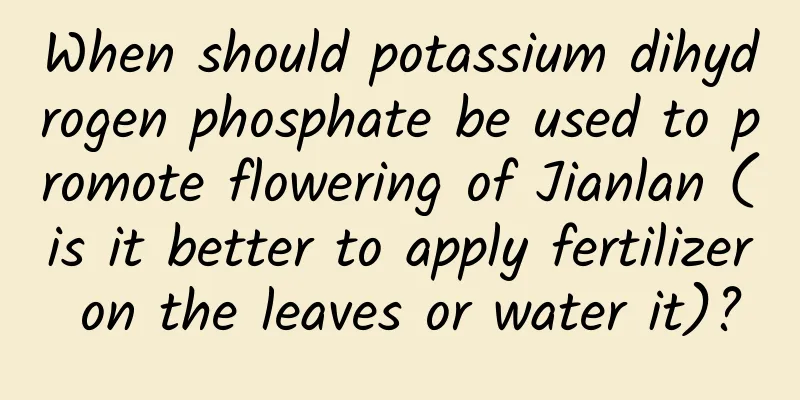When should potassium dihydrogen phosphate be used to promote flowering of Jianlan (is it better to apply fertilizer on the leaves or water it)?

|
In fact, the main components of potassium dihydrogen phosphate are phosphorus and potassium elements. As a flower-promoting fertilizer, it is mostly used to spray the leaves of orchids. The inorganic fertilizers commonly used for orchids are potassium dihydrogen phosphate and urea. Inorganic fertilizers contain different nutrients and have different effects on orchids, so you need to pay attention to their coordinated application, and pay special attention to making sure the concentration is light when applying . Jianlan blooms in summer and autumn. After the Qingming Festival in April, it should be sprayed with foliar fertilizer to promote the differentiation of flower buds. Spraying potassium dihydrogen phosphate foliar fertilizer on Jianlan is usually done in the evening on a sunny day when the sunlight cannot reach the orchid leaves. After spraying, attention should be paid to strengthening ventilation so that the orchid leaves dry within 1 hour. This is beneficial for the orchid to absorb nutrients at night and can also prevent the orchid leaves from being sunburned and causing local fertilizer damage. It is best to apply foliar fertilizer every 10 to 15 days to avoid excess nutrition. When spraying foliar fertilizer on Jianlan, the nozzle should be pointed upwards and the mist should be finer so that both sides of the orchid leaves can be sprayed. Moreover, since fertilizer is absorbed through the pores on the orchid leaves, and the pores of the leaves are mostly distributed on the back of the leaves, it is better to spray more on the back of the leaves, and it is better not to drip water on the leaves, so as to prevent the fertilizer liquid from gathering at the tip of the leaves and causing liquid accumulation and burning of the tips. In short, the application of potassium dihydrogen phosphate foliar fertilizer to Jianlan should be carried out during the flower bud differentiation period of Jianlan . It is mainly advisable to spray in mist form, and be careful not to allow too much liquid to accumulate at the tip of the leaf to avoid fertilizer injury and tip burn. In addition, the plant should be sprayed with clean water the next morning after fertilizing in the evening to wash away the residual fertilizer on the orchid leaves to avoid fertilizer damage caused by sunlight. |
>>: How to care for azalea to make it more vigorous (home care and management methods for azalea)
Recommend
What to do if the leaves of Jade Plant are alkaline (reasons of white mold on potted Jade Plants)
The main reasons why Jade Plant becomes alkaline ...
How to trim Milan flowers
Pruning during the seedling stage The shaping of ...
What is the best month to plant early watermelon?
When to plant early watermelon Generally speaking...
Does lettuce need to be watered every day?
Do you water the lettuce every day? The water req...
How to propagate Shibazakura
How to propagate Shibazakura There are three ways...
Cultivation methods and precautions of Osmanthus fragrans
1. Breeding methods 1. Soil: It is more suitable ...
How to prolong the flowering period of peony and regulate the flowering period of peony
1. How to prolong the flowering period 1. Prevent...
The language and legend of rapeseed flowers
1. Flower Language Rapeseed flowers look so ordin...
What is the best fertilizer for calla lily?
Calla lily fertilization time During its growth p...
Transformation of Dripping Guanyin from hydroponics to soil culture
1. Prepare the soil If you want to convert the hy...
How to save seeds of Cineraria
Cineraria seeds introduction Cineraria has seeds....
The difference between the fortune tree and the Schefflera
1. Fortune Tree It originates from Mexico. It bel...
Does spring rain prefer shade or sun?
Does spring rain prefer shade or sun? Spring rain...
How to care for grafted Christmas cactus
one. To control the lighting: Because the Christm...
How to plant oil sunflower and planting time and method
Oil sunflower growth environment requirements Sun...









